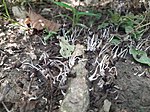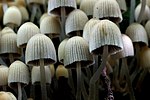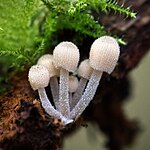
Coprinellus disseminatus, formerly known as Coprinus disseminatus and commonly known as the fairy inkcap,[1][2] fairy bonnet,[3] or trooping crumble cap,[4] is a species of agaric fungus in the family Psathyrellaceae. It can be found around dead wood in Europe and North America.
Taxonomy
The species was given its current name in 1939 by Jakob Emanuel Lange.[5]
Description
Coprinellus disseminatus grows to 4 centimetres (1+5⁄8 in) tall. The bell-shaped cap is tannish, becoming gray with age.[6] The spore print is blackish-brown.[7]
The species has about 143 sexes (mating types).[2]
Similar species
It is difficult to distinguish from related species or lookalikes in Tulosesus.[7]
Unlike most other coprinoid mushrooms, C. disseminatus does not dissolve into black ink (deliquesce) in maturity.[citation needed]
Distribution and habitat
The species grows on dead wood such as rotting stumps and is widespread across Europe.[6] It can be found in North America from June to November in the East and October to March near the West Coast.[7]
Uses
The species is nonpoisonous.[8] It can be eaten raw or cooked but does not preserve well.[6]
Gallery
-
Coprinus disseminatus; commonly known as "fairy inkcap" or "trooping crumble cap"
-
Trooping crumble caps closeup
-
Gills of trooping crumble cap
-
Trooping crumble caps
-
New born Trooping crumble caps
-
Trooping crumble caps
-
Dead Trooping crumble caps
-
Dying trooping crumble cap
-
Coprinus disseminatus; commonly known as "fairy inkcap" or "trooping crumble cap" in a tree
-
A close view of trooping crumble cap mushrooms.
-
A colony of trooping crumble cap mushrooms.
-
New born trooping crumble cap mushrooms.
-
Trooping crumble cap mushrooms.
-
The Fairy Inkcap, Coprinellus disseminatus, rarely ventures forth alone
-
Fairy Inkcap, Coprinellus disseminatus
-
New born trooping crumble cap mushrooms.
-
Trooping crumble cap mushrooms.
References
- ^ "Recommended English Names for Fungi in the UK-Revised". Scottish Fungi. Retrieved 2015-02-24.
- ^ a b Sujal S. Phadke (July 2018). "Sex begets sexes". Nature. 2 (7): 1063–1064. doi:10.1038/s41559-018-0597-0. PMID 29942014. S2CID 49410200.
- ^ Arora, David (1986). Mushrooms demystified: a comprehensive guide to the fleshy fungi (Second ed.). Berkeley: Ten Speed Press. ISBN 978-0-89815-169-5.
- ^ Harris H. (2014). Pocket Guide to Mushrooms. Bloomsbury Publishing. p. 118. ISBN 978-1-4729-1505-4.
- ^ Lange JE. (1938). "Studies in the Agarics of Denmark. Part XII. Hebeloma, Naucoria, Tubaria, Galera, Bolbitius, Pluteolus, Crepidotus, Pseudopaxillus, Paxillus". Dansk Botanisk Arkiv. 9 (6): 93.
- ^ a b c Francis-Baker, Tiffany (2021). Concise Foraging Guide. The Wildlife Trusts. London: Bloomsbury. p. 164. ISBN 978-1-4729-8474-6.
- ^ a b c Audubon (2023). Mushrooms of North America. Knopf. p. 593. ISBN 978-0-593-31998-7.
- ^ Miller Jr., Orson K.; Miller, Hope H. (2006). North American Mushrooms: A Field Guide to Edible and Inedible Fungi. Guilford, CN: FalconGuide. p. 227. ISBN 978-0-7627-3109-1.
External links

























